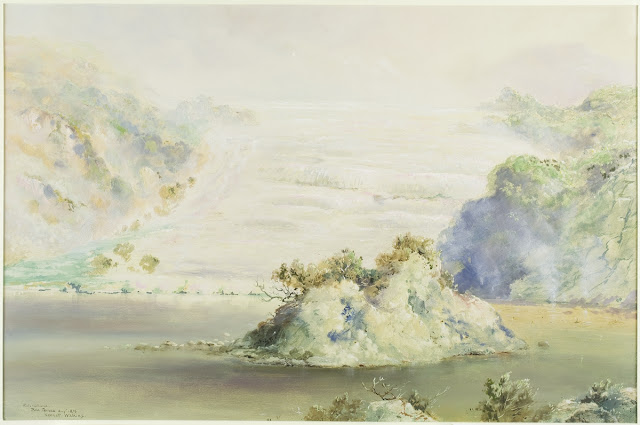Charles Blomfield 1848-1926
The White Terraces. Oil on
Canvas. 1901
Charles Blomfield “The artist of the Terraces” (Conly,
G 1985) was born in Holborn in London in 1848 and in 1862 he immigrated with
his family to New Zealand. He left London on a ship called the Gertrude and arrived five months later
in Auckland where he and his family settled.
Initially Charles found employment as a house painter and
interior decorator and was taught the techniques of the trade, including the
mixing of paint for decorative purposes. He developed his own business to
specialize in this work and had success in the field and he had no other formal
art training.
Auckland was soon to be enveloped by economic depression
and unemployment and Charles’ parents moved the family to Thames. It was here
that Charles found employment in the building trade as many people were
attracted to the area, (including William Crawford), to hunt for gold and the
demand for housing was high (Williams M. 2010).
It was in the Thames surroundings that Blomfield
became so attracted to painting native bush and local scenery. Regardless of
his lack of formal art training he soon realized his own talent and quickly
advanced his technique, mastering landscape painting. He started to travel
seeking scenery from which to compose works and he painted ‘plein air’, literally
sketching and using oil paints on canvas in the open at the site of interest
(this version of White Terraces however is a studio work due to its date of
1901). He carried all his painting equipment with him and this activity became
his passion.
When he returned to Auckland and he married Ellen Wild
in a Baptist chapel in Wellesley Street in 1874 and they set up home in
Ponsonby, where they raised seven children. While Ellen remained at home
raising the children he continued to travel the country on painting expeditions
(Williams M. 2010) The most usual way to travel to the Pink and White Terraces
was from Auckland by steamers of the Union Steam Ship Co. to Tauranga, and then
by horse drawn stage-coach between Tauranga and Rotorua via Maketu (Conly, G
1985) The lakes in the Rotorua and Tarawera region became fascinating to
Blomfield and paintings of Rotomahama and the Pink and White Terraces were to
become his trademark works.
According to his grand-daughter the writer Muriel Williams,
“Blomfield continued to travel throughout New Zealand
painting pictures of mountains, rivers, lakes and cloud effects, but his
greatest love remained the native bush, of which he wrote enthusiastically in
his diary. He had received some musical tuition on the voyage from England, and
supported himself by working as a music teacher and singing inspector in
schools, as well as by the sale of paintings.” (Williams,2010, para. 8)
On several of his expeditions he camped at Lake
Rotomahana where he studied the Pink and White Terraces. Fascinated by the
spectacle and their delicate beauty he made arrangements with local Tangata
Whenua in 1884, to pay a considerable fee to enable him to spend approximately
six weeks sketching and painting at the site (Williams M. 2010).
The eruption of Mount Tarawera took place early on the
morning of 10 June 1886 and this is when the Pink and White Terraces were
destroyed (Conly, G 1985).
Blomfield’s original oil paintings quickly became
unique after the eruption of Mount Tarawera and Blomfield was devastated at the
destruction of the Eighth Wonder the
Pink and White Terraces. He refused to sell the oil paintings but he made many
reproductions of them of which he sold many. The paintings became immensely
collectable and valuable to him and to the collectors of the period as they are
today. It is for these works that
he has become renowned and his studies of the Terraces have given insight to
many generations since, their spectacular natural beauty.
This Charles Blomfield painting “The White Terraces”
part of the Museum collection was the inspiration behind this exhibition and is
on long term loan to the museum. Unlike William Crawford and Kennet Watkins,
Blomfield did not have connections with Te Tairawhiti and did not live in the
region at all.
Muriel Williams. 'Blomfield,
Charles - Biography', from the Dictionary of New Zealand
Biography. Te Ara - the
Encyclopedia of New Zealand, updated 1-Sep-10
URL: http://www.TeAra.govt.nz/en/biographies/2b28/1
Conly. G. (1985). Tarawera: The Destruction of the Pink and
white Terraces. Wellington: Grantham House Publishing.










